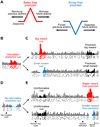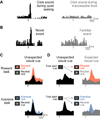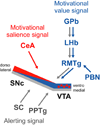Dopamine in motivational control: rewarding, aversive, and alerting
- PMID: 21144997
- PMCID: PMC3032992
- DOI: 10.1016/j.neuron.2010.11.022
Dopamine in motivational control: rewarding, aversive, and alerting
Abstract
Midbrain dopamine neurons are well known for their strong responses to rewards and their critical role in positive motivation. It has become increasingly clear, however, that dopamine neurons also transmit signals related to salient but nonrewarding experiences such as aversive and alerting events. Here we review recent advances in understanding the reward and nonreward functions of dopamine. Based on this data, we propose that dopamine neurons come in multiple types that are connected with distinct brain networks and have distinct roles in motivational control. Some dopamine neurons encode motivational value, supporting brain networks for seeking, evaluation, and value learning. Others encode motivational salience, supporting brain networks for orienting, cognition, and general motivation. Both types of dopamine neurons are augmented by an alerting signal involved in rapid detection of potentially important sensory cues. We hypothesize that these dopaminergic pathways for value, salience, and alerting cooperate to support adaptive behavior.
Copyright © 2010 Elsevier Inc. All rights reserved.
Figures








References
-
- Ahlbrecht M, Weber M. The resolution of uncertainty: an experimental study. Journal of institutional and theoretical economics. 1996;152:593–607.
-
- Albin RL, Young AB, Penney JB. The functional anatomy of basal ganglia disorders. Trends in neurosciences. 1989;12:366–375. - PubMed
-
- Anderson AK, Christoff K, Stappen I, Panitz D, Ghahremani DG, Glover G, Gabrieli JD, Sobel N. Dissociated neural representations of intensity and valence in human olfaction. Nat Neurosci. 2003;6:196–202. - PubMed
Publication types
MeSH terms
Substances
Grants and funding
LinkOut - more resources
Full Text Sources
Other Literature Sources
Medical

